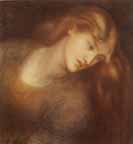
Dante Gabriel Rossetti's Aspecta Medusa shows Medusa not in her monstrous form, but as a beautiful woman. According to Greek mythology, Medusa was once a maiden so lovely that her beauty rivaled that of Athena herself — which is why the envious goddess transformed Medusa's hair into snakes writhing from her head. Anyone who glimpsed Medusa's horrific appearance would instantly turn into stone.
In this picture, however, Medusa retains her original beauty. She is the typical Rossettian ideal: she has a strong facial structure, her lips are full, and her long, reddish hair has been left loose and flowing. Yet she has an air of doom about her. Medusa merges with the murky background, gazing downwards into the darkness as her head tilts ominously to the side.
Rossetti wrote a poem to accompany the drawing:
Andromeda, by Perseus sav'd and wed,
Hanker'd each day to see the Gorgon's head:
Till o'er a fount he held it, bade her lean,
And mirror'd in the wave was safely seen
That death she liv'd by.
Let not thine eyes know
Any forbidden thing itself, although
It once should save as well as kill: but be
Its shadow upon life enough for thee.
1. Why might Rossetti have chosen to depict Medusa in her beautiful state rather than in her monstrous state?
2. In the second stanza of the poem, Rossetti seems to be commenting on the place of the artist as both seeking truth and being destroyed by truth. How does the figure of Medusa relate to the situation of the artist?
3. In the myth, Medusa's stare turned people to stone. In the drawing, however, Medusa is the one averting her gaze. Why might this be so?
4. Medusa may be considered one of the ultimate femme fatale figures, but is this reflected in Rossetti's portrayal of her? How does Aspecta Medusa compare to Lady Lilith, for example? Which woman appears more powerful and dangerous?
Last modified 27 June 2020